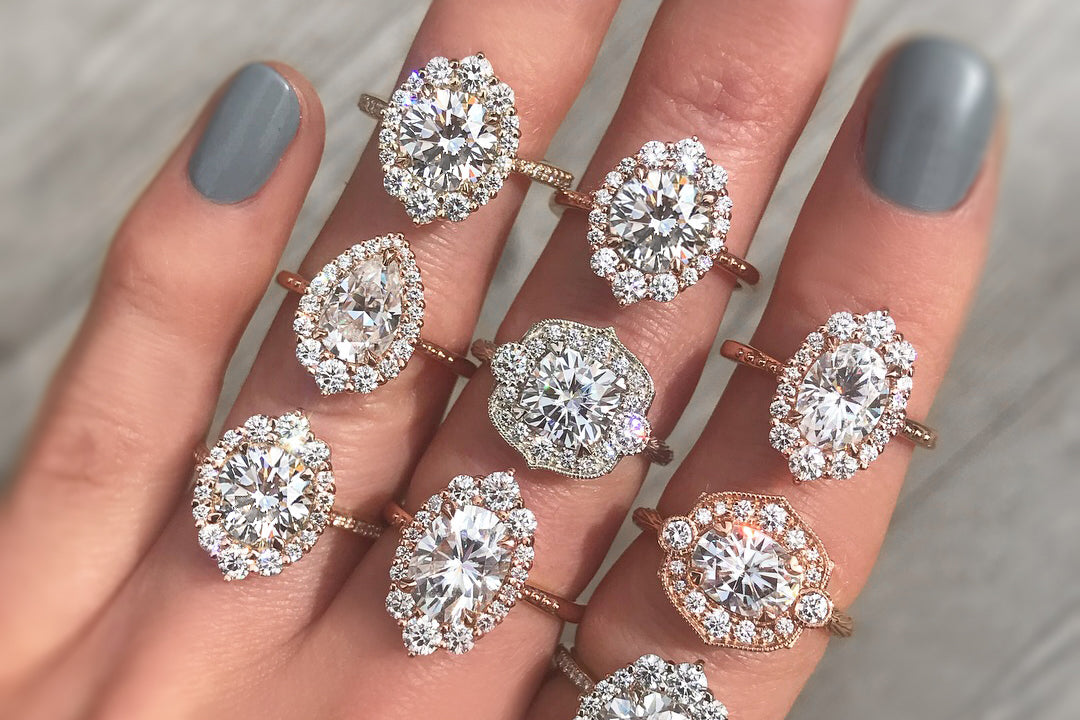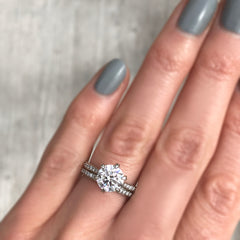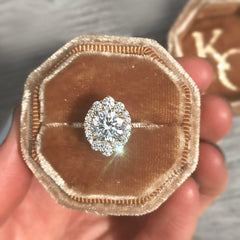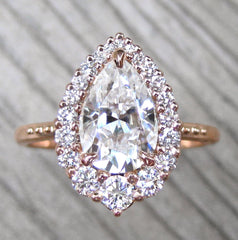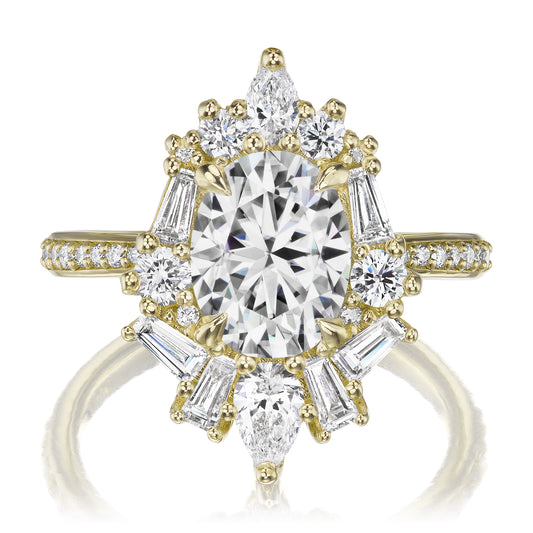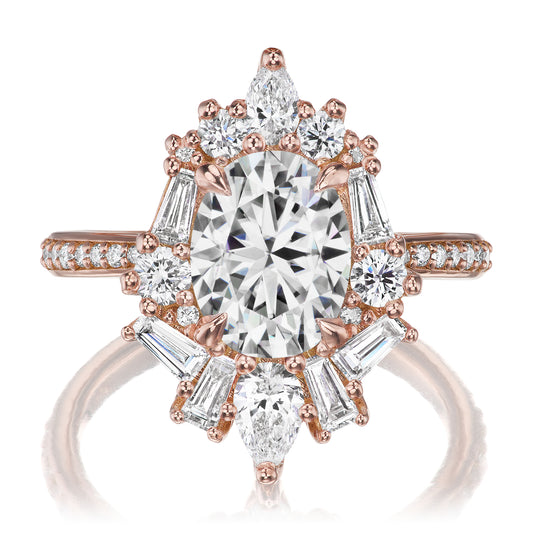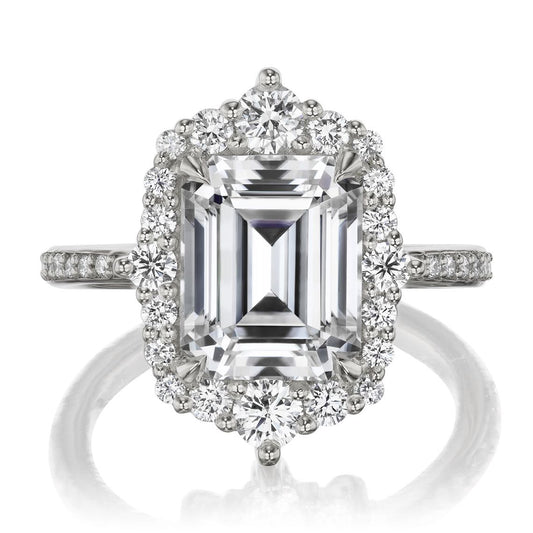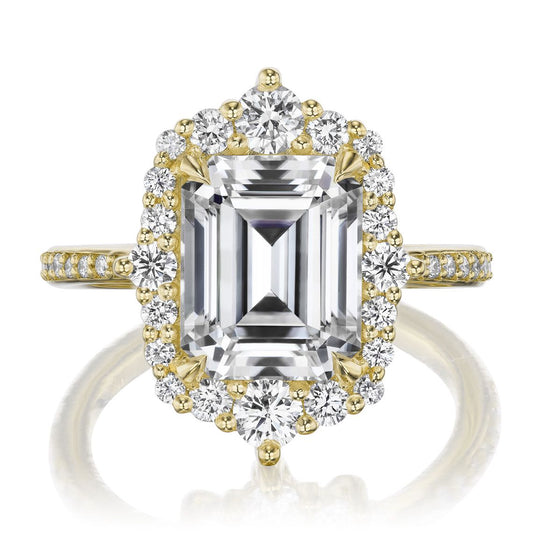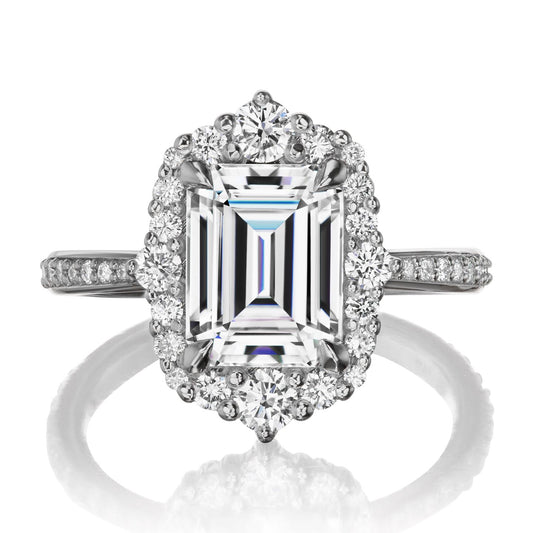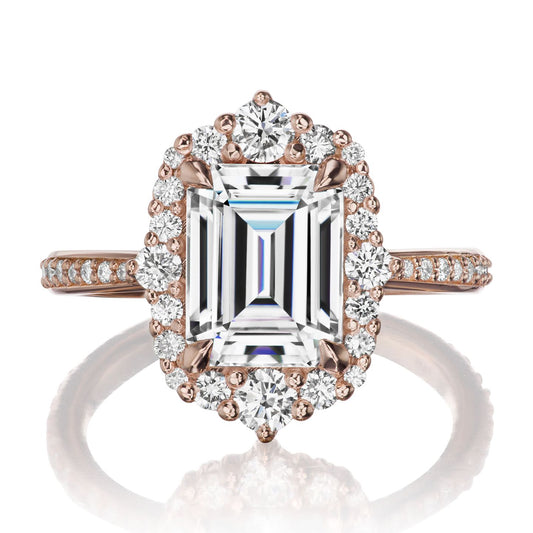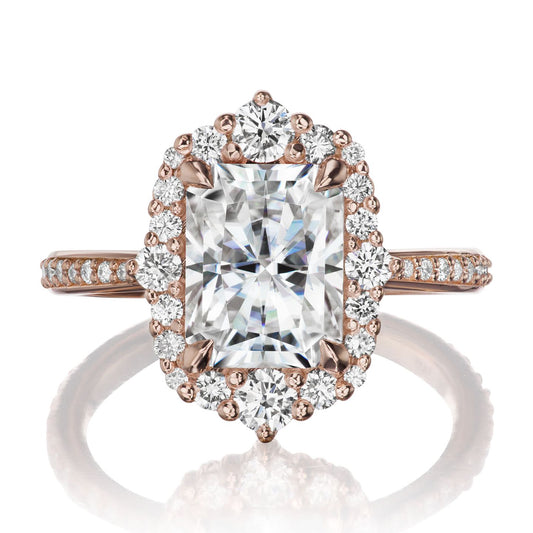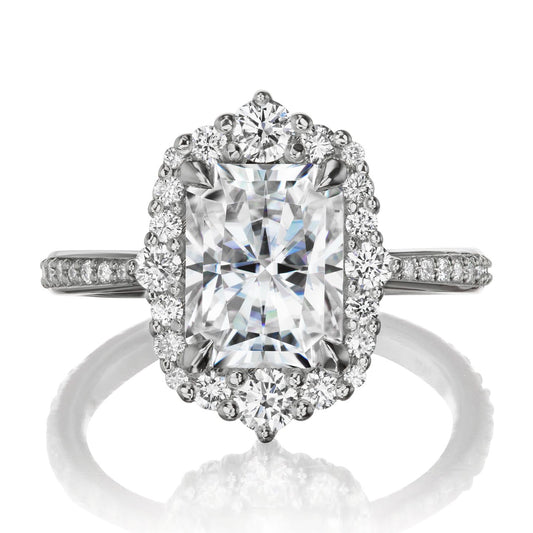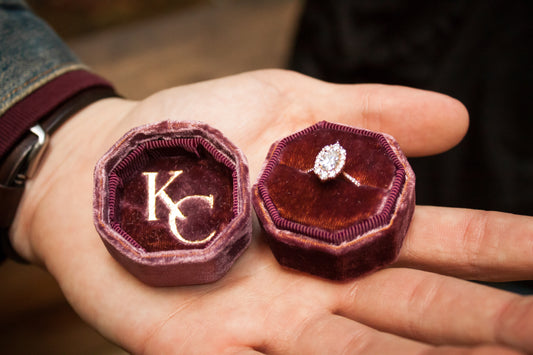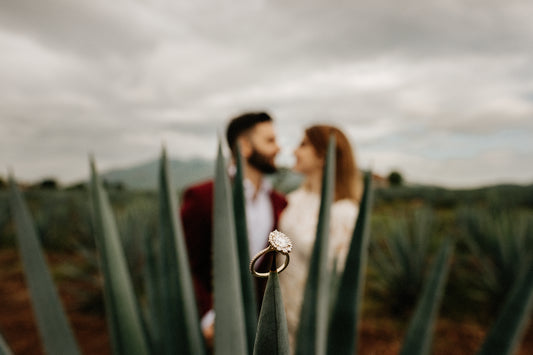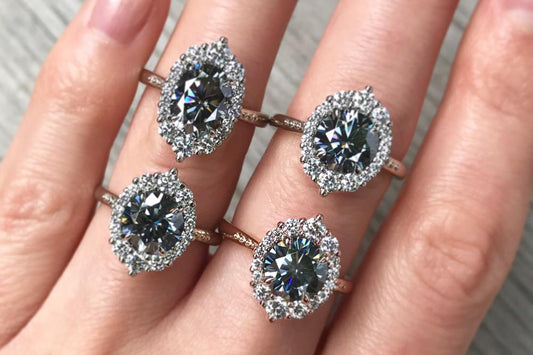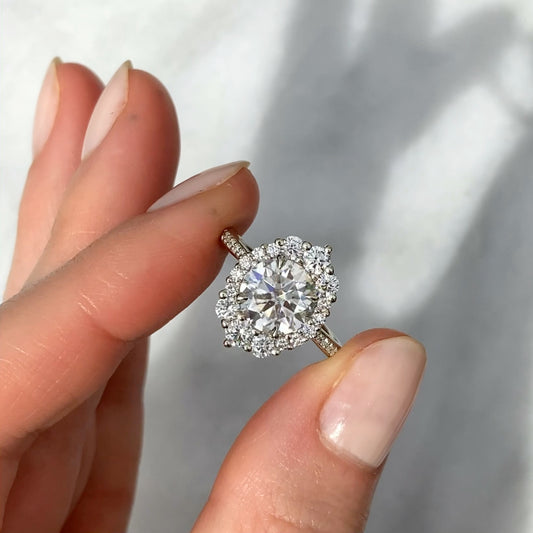What's the difference between diamond, lab-grown diamond, moisssanite, and white sapphire?
Each of these gemstones is an entirely different mineral, with its own chemical makeup and inherent properties. All are clear stones, and the attributes of each can be very similar in some cases, or pretty darn different in others. It can be easy to see a clear gem, and assume it'll have the same properties as diamond (the stone you're likely most familiar with), but it's nice to know some key differences between diamonds (mined and lab-grown), moissanite, and white sapphires, before deciding which stone is right for you. This post will have some facts, some photos, and some personal opinions -- because, what's the fun if I can't infuse a little personal opinion?
Diamond:
Diamonds are the hardest mineral on earth, ranking at a 10 on the Moh's Scale of Hardness. (If you're not familiar with the scale, take a peek at my blog post on the Moh's and stone durability.) Hardness is an important feature for an everyday ring meant to be worn for years. Diamonds also have wonderful fire and brilliance, producing that sparkle we all know and love from diamonds. Because of their amazing ability to reflect light back up to our eyes, it means they'll sparkle even when dirty. In a perfect world, your rings would be clean all the time and you'd remember to remove them every time you wash your hands. The reality, however, is that soap scum buildup, water residue, lotions, etc. will cause gunk buildup behind your stone. Even with that gunk, diamonds are so good at creating sparkle, they don't need a clean background. A clean stone will be even more blinding, but a dirty diamond will still sparkle. As I like to say, a diamond can even sparkle in a dark room.
Diamonds come in a range of qualities, which means there are a range of clarity and color grades. For my clear/white diamonds, I typically stay in the VS - SI clarity range, and D - H color range. That translates into high-end clarity, and colorless to near-colorless diamonds. The downside? -- mined diamonds are pricey, especially high quality ones. They are also mined from the earth, which some clients may prefer to avoid. Though we've made great strides toward ethical diamond mining, the industry is still fraught with many issues.
Lab-Grown Diamond:
These diamonds are grown in laboratories that recreate the same environment that causes diamonds to form in the earth. Lab-grown diamonds have the exact same molecular composition and optical properties as a mined diamond. That means you'll get the exact same sparkle and durability as a mined diamond -- but without the environmental or social impacts of mining. Even highly trained gemologists are unable to tell the difference! They're available in all ranges of color and clarity grades, so you can purchase depending on your preferences. Lab-grown diamonds come in less expensive than their mined counterparts, giving you the exact same look at a more affordable price point. Lab-grown diamonds are still a fairly pricey option, priced higher than moissanite. Learn more in my other blog post that's focused on lab-grown diamonds.
Moissanite:
Moissanite is also a lab-grown gem, but it has a different molecular makeup than diamond. It looks and behaves extremely similarly to diamond, but is a little bit different. (If you're unsure of what moissanite is, take a peek at Charles & Colvard's website first -- they're the makers of the Forever One™, and the originators of moissanite.) Moissanites are available in colorless and near-colorless options, with eye-clean clarity, so they're very similar in clarity and color when compared to the high quality diamonds I use. Moissanites' sparkle is as great as diamond, even in a dark room or when your ring isn't freshly cleaned. Their durability ranks second only to diamond, and is one of the hardest materials on earth (even harder than sapphire or ruby).
Because it's also created gem, it's free of environmental and social issues, making it an ethical choice. Charles & Colvard's moissanite is crafted right here in the US and is certified as USA made. Of all the white gemstone alternatives, moissanite looks and behaves the most like diamond. When viewed side by side, diamond and moissanite are typically indistinguishable. Case and point, take a peek at this Instagram video below I recently posted comparing a Charles & Colvard Forever One Hearts & Arrows moissanite and a lab-grown diamond. Can you guess which is which?
Wanting to know about which moissanite cut behaves the most diamond-like? Check out this blog post comparing the moissanite cuts I choose to offer.
White Sapphire:


White sapphires rank at a 9 on the Moh's Scale, giving it a top 3 spot for hardness. Sapphire isn't as durable as diamond or moissanite, but it's still one of the hardest gemstones. It's a great option for someone looking for a stone from the earth (rather than a cultured lab-grown stone). White sapphire is also a very affordable price point.
The major downside to white sapphire is it requires frequent cleaning. White sapphires inherently don't have the same ocular properties as diamond or moissanite. They have a lower refractive index and lesser fire (less sparkle). That means that as the stone gets dirty (soap scum buildup beneath it, lotions, even simple water spots), its facets won't continue to reflect as successfully as a dirty diamond or moissanite. The better sparkle of a diamond or moissanite means that even when there's dirt beneath it or water spots, it's able to reflect light back up to the eye. Sapphire, however, appears more transparent and looks best with a clean background. In order to keep your white sapphire looking the way it did when you received it, you'll have to clean it frequently. Cleaning can be done using an at home method, or just pop into a local jewelry store and have them use the ultrasonic cleaner.
Although sapphire is a very hard mineral, it can show signs of wear after years of wearing it regularly. It depends on how hard you are on your hands, or if you take care to remove your ring when doing activities. Sapphires can get a sort of "frosted" appearance after many years as the tiny edges of their facets wear. (Think the frostiness of sea glass, but just at the edges where the facets meet.)
Bonus! White Topaz + White Zircon + Cubic Zirconia:
There are several other clear/white minerals, which are often seen as engagement ring alternatives. White zircon, white topaz, and cubic zirconia (CZ) are sometimes confused for diamond/moissanite/white sapphire. They're really affordable, so why not use them? The main reason I'd advise against topaz, zircon, or CZ goes back to durability. CZ ranks at 8-8.5, topaz ranks at an 8, and zircon is just a 6-7.5 on the Moh's Scale. All will show signs of wear quickly: scuffing (gives sort of a frosty/milky appearance to the stone), or even worse -- chipping, breaking, or cracking.
I'm sometimes asked by clients if I can set a topaz or CZ in a setting for now, and then they'd save up and replace it sometime with a more durable stone. I completely understand the need to stay within your budget, and I never try to talk a customer into spending more than they feel comfortable with. But some options just don't make economical sense, and I think it's my responsibility to be up front about future costs. For example, to purchase one of my mountings with a CZ might save you $100 when compared to the same ring set with white sapphire. To then purchase a loose sapphire later on and swap it for the CZ can cost you a few hundred bucks. (This is also assuming the setting doesn't require building up or re-tipping prior to resetting, or sometimes even a complete remaking of the mounting.) In the end, you're spending much more money. And for an everyday ring, it's pretty much guaranteed that you would need to replace your CZ/topaz/zircon at some point.
So, which should I choose?
That, my friends, is up to you. Hopefully I was able to provide some helpful info and opinions about each one. Now it's up to you to decide whether a diamond, a moissanite, or a white sapphire will fit your lifestyle, budget, and philosophy best. If you have any additional questions about which stone to go with in one of my rings, please don't hesitate to email me directly. I'm always happy to give my own personal opinion for a particular design ;)

